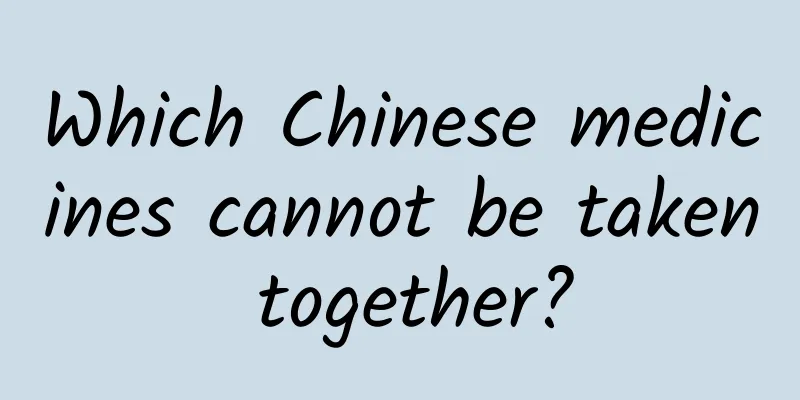Which Chinese medicines cannot be taken together?

|
Chinese medicine is not taken alone. Each patch of medicine is a mixture of multiple Chinese medicines, and the treatment prescription for each disease is clear. You cannot add or subtract medicines at will, otherwise the efficacy will change and the drug treatment will also be affected. In severe cases, drug poisoning and other hazards will occur. So which Chinese medicines cannot be taken together? There are many Chinese medicines that cannot be taken together, and their medicinal properties are also complex. We can control the drug incompatibility according to relevant requirements. 1. Incompatibility taboos: In the previous section on “Compatibility”, it was mentioned in principle that some drugs should be avoided in combination. The Shennong's Herbal Classic describes the relationship between these medicines as "mutually hostile" and "opposite." According to statistics in "Shu Materia Medica", among the medicines listed in "Ben Jing", there are sixty that are mutually incompatible and eighteen that are opposite to each other. There is no consistent statement in ancient books about the understanding and development of compatibility taboos throughout the ages. During the Jin and Yuan Dynasties, they were summarized as "Nineteen Fears" and "Eighteen Antidotes" and compiled into a rhyme. The contents of the rhyme are listed below. (1) Nineteen Fears: Sulfur is afraid of potassium nitrate, mercury is afraid of arsenic, wolfsbane is afraid of realgar, croton is afraid of morning glory, clove is afraid of Curcuma, Chuanwu and Caowu are afraid of rhinoceros, saltpeter is afraid of Trigonella, cinnamon is afraid of litharge, and ginseng is afraid of Aconiti Lateralis Preparata. (2) Eighteen Antidotes: Licorice is counterproductive with Ginseng, Euphorbia, Sargassum, and Daphne; Aconitum is counterproductive with Fritillaria, Cucurbitacin, Pinellia, Bletilla striata, and Bletilla striata; Veratrum is counterproductive with Ginseng, Adenophora, Salvia miltiorrhiza, Scrophularia, Asarum, and Paeonia lactiflora. There are slight differences in the records in subsequent books such as "Compendium of Materia Medica" and "Yaojian", but they are not as widely recognized and spread as the "Eighteen Antidotes" and "Nineteen Fears Songs". The "Shennong Bencao Jing·Preface" points out that "do not use things that are incompatible or opposite to each other" and "if there is poison, it should be controlled. You can use things that are fearful or killing each other, but do not use them together." Since the Song Dynasty, the relationship of "mutual fear" has also been listed as a taboo in compatibility, and it has been confused with "mutual hostility". Therefore, the concept of "Nineteen Fears" has a different meaning from "mutual fear", one of the "Seven Emotions" discussed in the "Compatibility" section. Some of the "Nineteen Fears" and "Eighteen Antidotes" medicines are somewhat different from their actual applications, and doctors of all dynasties have discussed this and cited ancient prescriptions as evidence to prove that certain medicines can still be used together. For example, in Ganying Pills, croton and morning glory are used together; in Gansui Banxia Decoction, licorice and gansui are used together; Sanzhong Kuijian Decoction and Haizao Yuhu Decoction both use licorice and seaweed together; Shixiang Fanhun Pill uses clove and turmeric together; Dahuoluo Pill uses aconite and rhinoceros horn together, and so on. There is not much research work in this area in modern times. Some experimental studies have preliminarily shown that when licorice and gansui are used together, the toxicity mainly depends on the dosage ratio of licorice. If the dosage of licorice is equal to or greater than that of gansui, the toxicity is greater. For example, when Fritillaria and Pinellia are used together with Aconitum, no obvious enhancement of toxicity is observed. When Asarum is combined with Veratrum, it can cause poisoning and death in experimental animals. Since the research on the "Nineteen Fears" and "Eighteen Antidotes" still needs further in-depth experiments and observations, as well as study of their mechanisms, a cautious attitude should be adopted at present. Generally speaking, for some of these drugs, blind use should be avoided without sufficient basis and application experience. Which Chinese medicines cannot be taken together? To control the Chinese medicines that cannot be taken together, you can pay attention to the contraindications of the medicines. By following the principles explained in the article, you can avoid the incompatibility of many medicines. Various problems will arise when they conflict with each other. The correct combination of medicines is a good medicine. If the wrong combination of medicines is used, it is a poison. Doctors must have their own criteria for prescribing medicines and cannot do it casually. Otherwise, a drug efficacy accident is very serious and the damage to patients will be increased. |
<<: What are the medicinal values of white wax?
>>: What can't be eaten with Cordyceps?
Recommend
Does every typhoon have a unique name? Those that are too fierce will be removed from the list!
Little-known fact: every typhoon has its own uniq...
The efficacy and function of Lung Meridian Grass
The role and efficacy of lung meridian grass Lung...
The effect of deer grass
Many people have heard of deer essence grass, whi...
The "14th Winter" curling competition is hot! If you want to play curling well, you need more than just two brushes
Curling is a traditional winter competition event...
Google & Compete: Survey shows that consumers visit more than 17 travel websites and conduct more than 4 searches before booking a hotel.
We all know that online travel consumers conduct ...
The efficacy and function of Tibetan antelope horn
Tibetan antelope horn is one of the common tradit...
The efficacy and function of Chunjian oil
Chinese medicinal materials are very common, and ...
The efficacy and function of peach leaves
Peach leaves are something that many people are v...
The efficacy and function of Pseudotumorhynchus pubescens
Pseudotoma fern is a very common Chinese medicine...
The efficacy and function of hand ginseng
The medical value of ginseng is beyond our imagin...
The efficacy and function of duck meat
With the development of society and the close int...
The efficacy and function of quercetin
Everyone is familiar with the black pea. It has a...
The "icebreaker" on the "Xuelong" is China's first female seafarer to cross the Arctic Ocean
On November 4, the first domestically built large...
More than 5,000 yuan is gone with just one sip of hot water. How deadly is this sip of hot water?
recently A netizen was in a hurry to go out Drink...
Spending $1.7 billion and traveling hundreds of millions of kilometers just to listen to the sound of the ocean there.
Jupiter is the largest planet in the solar system...









